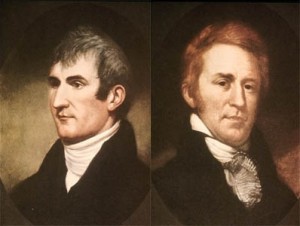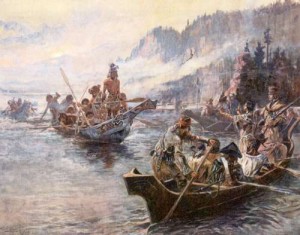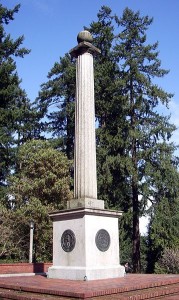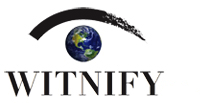August 5th 1804
Killed a serpent on the bank of the river adjoining a large prarie.
prarie.
Length from nose to tail–5’2″
Circumpherence in largest part–41/2
Number of scuta on belly–221
Do. on Tale–53
No pison teeth therefore think him perfectly inocent–eyes, center black with a border of pale brown yellow Colour of skin on head yellowish green with black specks on the extremity of the scuta which are pointed or triangular colour of back, transverse stripes of black and dark brown of an inch in width, succeeded by a yellowish brown of half that width the end of the tale hard and pointed like a cock’s spur the sides are speckled with yellowish brown and black.–two roes of black spots on a lite yellow ground pass throughout his whole length on the upper points of the scuta of the belly and tale 1/2 Inch apart this snake is vulgarly called the cow or bull snake from a bellowing nois which it is said sometimes to make resembling that anamal, tho as to this fact I am unable to attest it never having heard them make that or any other noise myself.
I have frequently observed an acquatic bird in the cours of asscending this river but have never been able to procure one before today, this day I was so fortunate as to kill two of them, they are here more plenty than on the river below. they lay their eggs on the sand bars without shelter or nest, and produce their young from the 15th to the last of June, the young ones of which we caught several are covered with down of a yellowish white colour and on the back some small specks of a dark brown. they bear a great resemblance to the young quale of ten days oald, and apear like them to be able to runabout and peck their food as soon as they are hatched–this bird, lives on small fish, worms and bugs which it takes on the virge of the water it is seldom seen to light on trees an quite as seldom do they lite in the water and swim tho the foot would indicate that they did it’s being webbed I believe them to be a native of this country and probly a constant resident.
The weight of the male bird is one ounce and a half, its length from beak to toe 71/2 inches from tip to tip of wing across the backbone foot seven inches and a half the beak is one 1/8 inch long, large  where it joins the head Elated on the sides and tapering to a sharp point, a little declining and curvated, a fine yellow, with a shade of black on the extremity of upper beak; the eye is prominent, black and on a angular scale of 1/2 Inc; occupyse 3 1/3 in width. the upper part of the head is black from the beak as low as the middle of the eye and a little below the joining of the neck except however some white which joins the upper part of the beak which forks and passing over the sides of the forehead terminate above each eye–the under part of the bird, that is the throat and cheeks as high as the eye, the neck brest belly and under part of the wings and tail are of a fine white, the upper part of the neck, back, and wings are of a fine, quaker colour, or bright dove colour with rather more of a bluish tint-except however the three first or larger feathers in the wing which on upper side are of a deep black. The wing has four joints:
where it joins the head Elated on the sides and tapering to a sharp point, a little declining and curvated, a fine yellow, with a shade of black on the extremity of upper beak; the eye is prominent, black and on a angular scale of 1/2 Inc; occupyse 3 1/3 in width. the upper part of the head is black from the beak as low as the middle of the eye and a little below the joining of the neck except however some white which joins the upper part of the beak which forks and passing over the sides of the forehead terminate above each eye–the under part of the bird, that is the throat and cheeks as high as the eye, the neck brest belly and under part of the wings and tail are of a fine white, the upper part of the neck, back, and wings are of a fine, quaker colour, or bright dove colour with rather more of a bluish tint-except however the three first or larger feathers in the wing which on upper side are of a deep black. The wing has four joints:
| No. Joint | Length of Joint | No. of Feathers | Length of do. |
| 1 | 1 1/2 | a Clump of feathers not strong but loosly connect with the flesh of the wing | 1/2 |
| 2 | 2 | 16 | 2 |
| 3 | 1 1/2 | 7 | from 2 1/2 to 4 1/2 |
| 4 | 3/4 | 3 | 5 1/2 |
The tail has eleven feathers the outer of which are an inch longerthan those in the center gradually tapering inwards which gives the tale a forked appearance like that of the swally the largest or outer feather is 23/4 that of the shortest 13/4–the leg and thye are three inches long the leg occupying one half this length the thye is cove
 red with feathers except about 1/4 of an inch above the knee the leg is of a bright yellow and nails long sharp and black the foot is webbed and has three toes forward; the heel or back toe is fixed to the leg above the palm of the foot, and is unconnected by a web to the other toes, it has no nail. the wings when foalded lap like those of the swallow and extend at least an inch and a half beyond the tale. this bird is very noysey when flying which is dose exttreemly swift the motion of the wing is much like that of kildee it has two notes one like the squaking of a small pig only on reather a high kee, and the other kit’-tee’- kit’-tee’–as near as letters can express the sound–the beak of the female is black and the black and quaker colour of the male in her is yellowish brown mixed with dove colour”
red with feathers except about 1/4 of an inch above the knee the leg is of a bright yellow and nails long sharp and black the foot is webbed and has three toes forward; the heel or back toe is fixed to the leg above the palm of the foot, and is unconnected by a web to the other toes, it has no nail. the wings when foalded lap like those of the swallow and extend at least an inch and a half beyond the tale. this bird is very noysey when flying which is dose exttreemly swift the motion of the wing is much like that of kildee it has two notes one like the squaking of a small pig only on reather a high kee, and the other kit’-tee’- kit’-tee’–as near as letters can express the sound–the beak of the female is black and the black and quaker colour of the male in her is yellowish brown mixed with dove colour”
Source: Gutenberg
Comment |

 Share on Facebook
Share on Facebook
 Tweet
Tweet
 Add My Story
Add My Story






